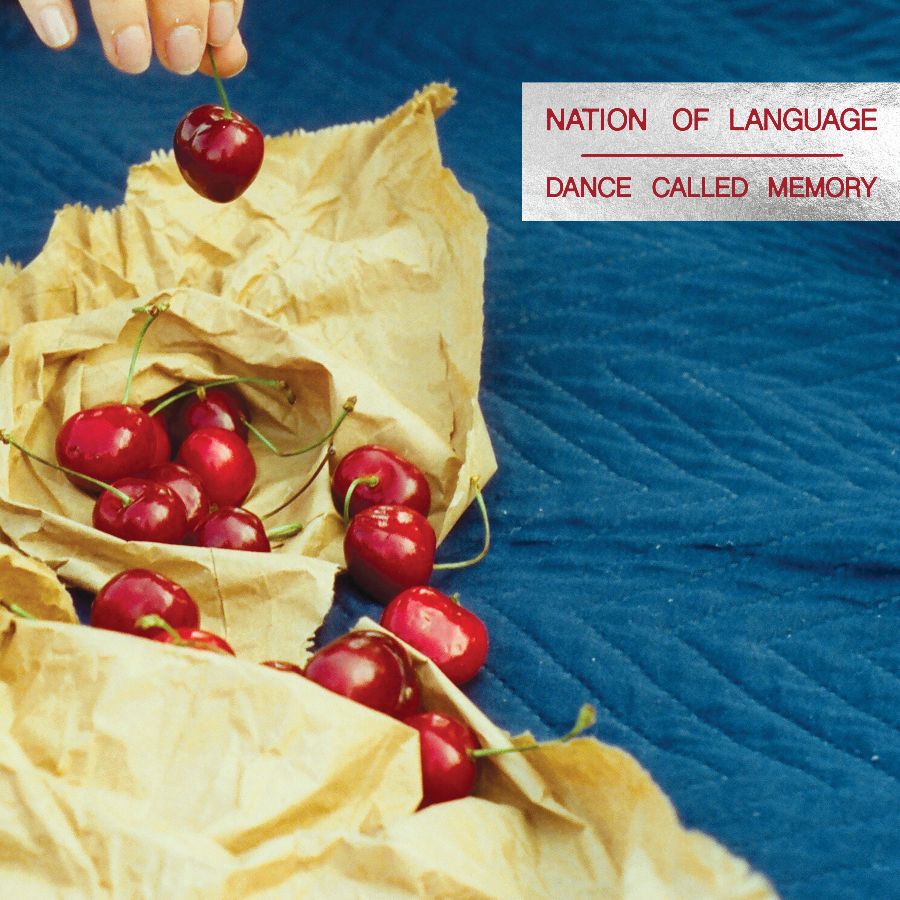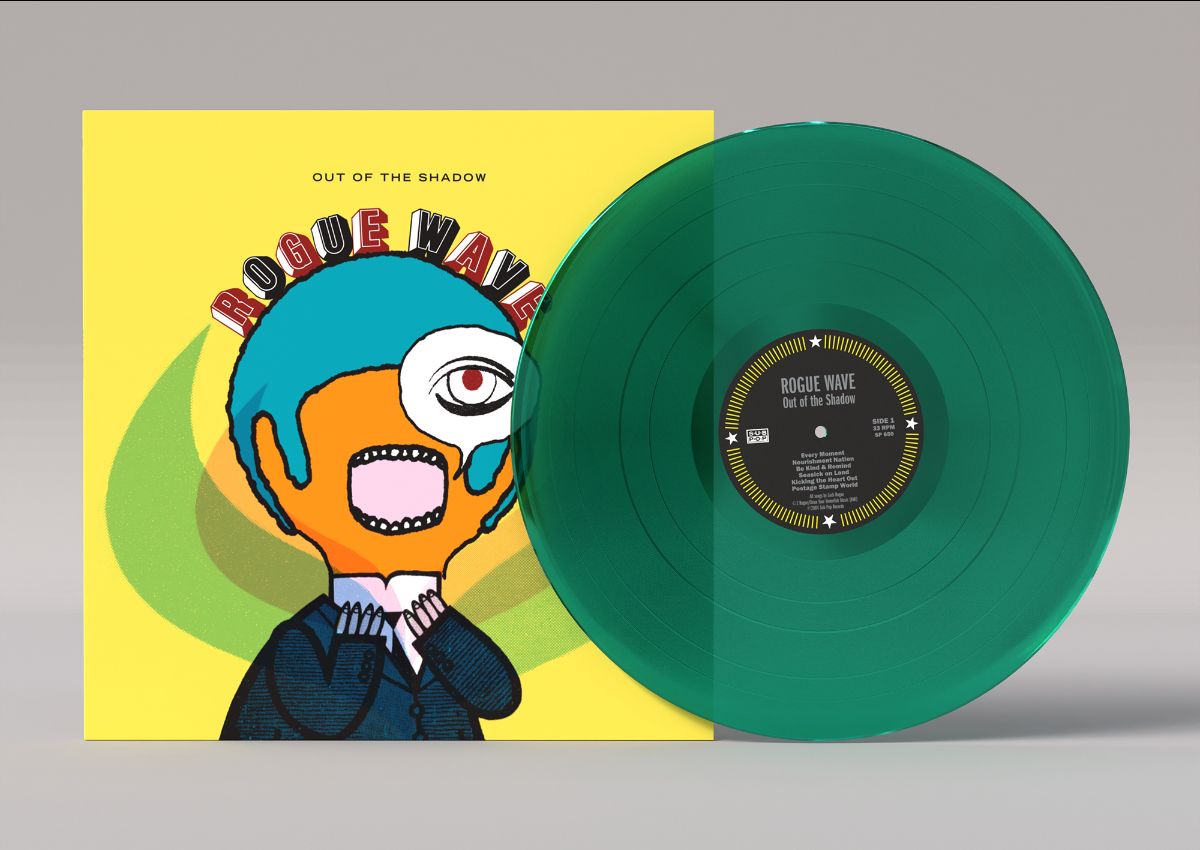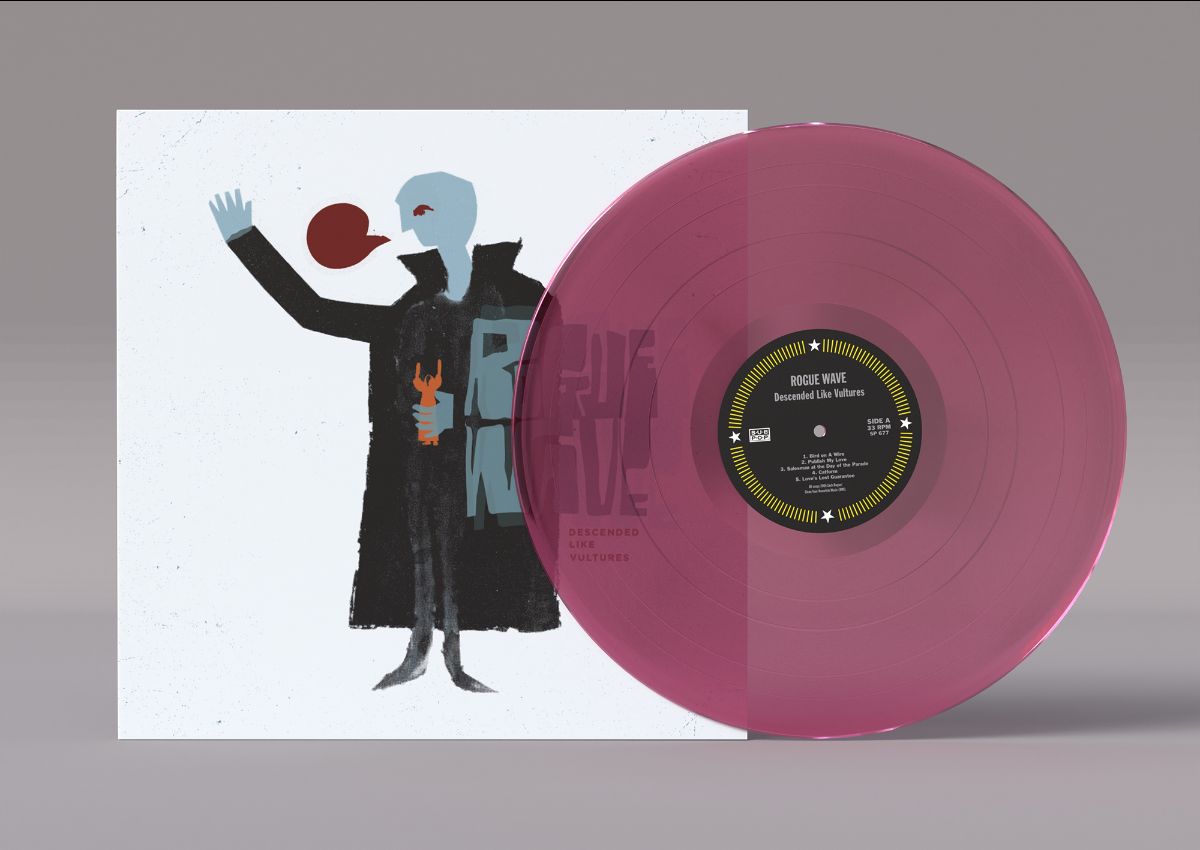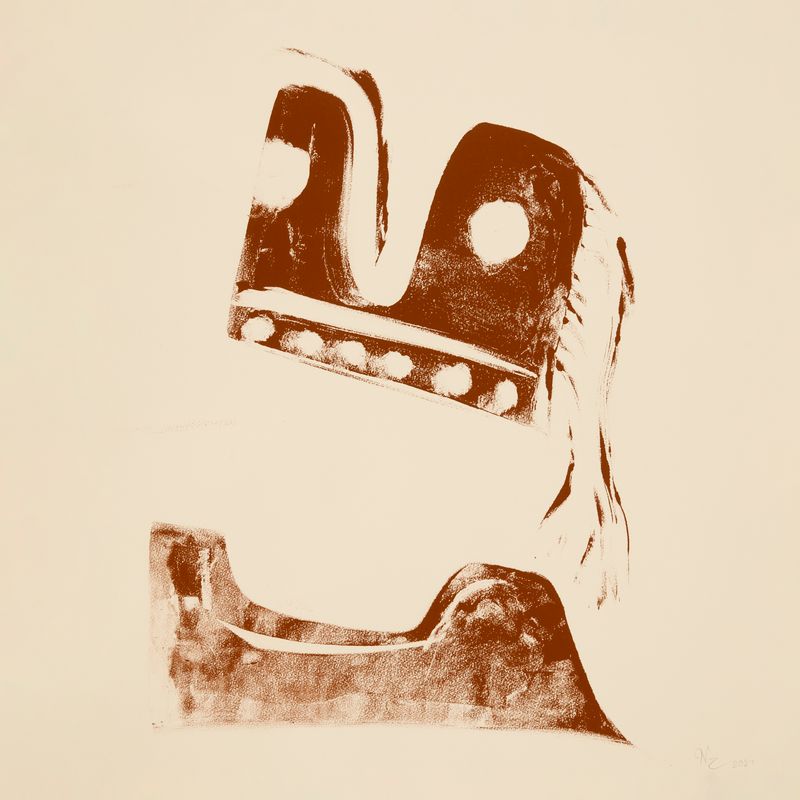Today, November 12th, Nation of Language is sharing a new, official video for ”Nights of Weight,” a tender and bittersweet ballad from Dance Called Memory. The intimate performance-style video, directed by Sean Devaney, was shot on set between takes for the “Inept Apollo” and “I’m Not Ready For The Change” videos, and stars band frontman Ian Devaney.
Yesterday, Dance Called Memory was selected for Rough Trade Records’ “Albums of the Year 2025” best of list, and to celebrate, fans can now preorder a new, limited-edition variant from the retailer on Crystal Clear / Opaque Black Marbled vinyl.
Dance Called Memory, the group’s fourth album, is out now worldwide from Sub Pop. The 10-track long player features the Top 30 AAA radio singles “Inept Apollo” and “I’m Not Ready For The Change,” and was recorded, produced, and mixed by returning producer and collaborator Nick Millhiser in New York City and mastered by Heba Kadry in Brooklyn. Dance Called Memory recently hit the Top 5 on the NACC 200 College Radio Chart.
Nation of Language’s 51-date, 2025 international headlining tour to support Dance Called Memory has been the band’s most successful touring run to date. The tour has sold over 40k tickets so far, with sold-out shows in New York, DC, Chicago, Vancouver (BC), Seattle, Portland, San Diego, Austin, San Francisco, Dublin, Paris, and tonight‘s performance at the Roundhouse, their largest London play to date (Nov. 12th). The tour will continue through Friday, November 28th, in Lisbon, PT at LAV.
Support for the UK/EU shows will come from Partisan Records act Westerman (through Nov. 22nd).
Nation of Language has also scheduled a few 2026 shows, including a rescheduled date on January 3rd in Kansas City, MO, at The Truman, and an appearance at Primavera Sound in Porto, PT, June 11th-14th. Additional dates to be announced soon.
November 2025
UK/EU Headlining Shows
Wed. Nov. 12 - London, UK - The Roundhouse ^ [Sold Out]
Fri. Nov. 14 - Paris, FR - Elysee Montmartre ^ [Sold Out]
Sat. Nov. 15 - Amsterdam, NL - Melkweg ^
Sun. Nov. 16 - Nijmegen, NL - Doornroosje ^
Tue. Nov. 18 - Cologne, DE - Gloria ^
Wed. Nov. 19 - Hamburg, DE - Uebel & Gefährlich ^
Fri. Nov. 21 - Berlin, DE - Columbiahalle ^
Sat. Nov. 22 - Munich, DE - Technikum ^
Sun. Nov. 23 - Milan, IT - Magazzini Generali
Wed. Nov. 26 - Barcelona, ES - Razzmatazz
Thu. Nov. 27 - Madrid, ES - La Riviera
Fri. Nov. 28 - Lisbon, PT - LAV
^ w/ Westerman
2026 Tour Dates
Jan. 03 - Kansas City, MO - The Truman
Jun. 11-14 - Porto, PT - Primavera Sound Porto Parque Da Cidade
What People Are Saying About Nation of Language’s
Dance Called Memory:
“The real deal…” ★★★★ MOJO
“The band’s fourth LP and Sub Pop debut is danceable, eccentric, and immaculate at once…” ★★★★ All Music
“For Dance Called Memory, the trio — Devaney, his wife and right-hand synth wizard Aidan Noell, and bassist Alex MacKay — once more teamed with LCD Soundsystem/Holy Ghost! member Nick Millhiser as producer. Together, the crew pushed the edges of NOL’s sound, creating something expansive enough to capture the weight of grief and loss that coursed through these new songs.” Stereogum
“Dance Called Memory, continues its study of synth-pop from the late 1970s and early ’80s. The new record adds more guitars to the mix, tempering the machine-made with a human touch.” New York Times
“It’s a fuzzy electronic project that’s both introspective and danceable, with flanged New Order–styled guitar parts sprinkled in to give their sound a refreshed feel.” FLOOD
“Ian Devaney’s Vulnerability Pays Off On Nation of Language’s Dance Called Memory.” 8.0/10, PASTE
“If there were a Nation of Language album that lifts the band onto the next rung of the pop culture ladder, beyond indie notoriety, it deserves to be this one.” “Best Albums of September,” Consequence
“entwined with beauty as much as melancholy.” Our Culture
★★★★ Live4ever
“an assured evolution” ★★★★ ½ Indie is Not a Genre
“A resounding triumph” When The Horn Blows
“another stellar record from Nation of Language” ★★★★ Stereoboard
“this Brooklyn outfit’s gleaming spirit continues to be a northern star” Electronic Sound
“a band that has the songs (and the heart) to cross the pop threshold if they choose.” The Line of Best Fit

Nation of Language
Dance Called Memory
Tracklisting:
1. Can’t Face Another One
2. In Another Life
3. Silhouette
4. Now That You’re Gone
5. I’m Not Ready for the Change
6. Can You Reach Me
7. Inept Apollo
8. Under the Water
9. In Your Head
10. Nights of Weight
Filmmaker, author, comedian, and cultural icon extraordinaire, John Waters, 79, returns with his second Christmas parody single (and third holiday single with Sub Pop), “John Waters covers ‘Little Cindy,’” produced again by his longtime friend and colleague, Grammy-winner, Ian Brennan (Tinariwen, Parchman Prison Project, The Good Ones [Rwanda], Ramblin’ Jack Elliott).
Waters says, “In the tradition of novelty records, which I’ve always loved, this year I pay tribute to one of my favorite hymns that was once included in my ‘John Waters Christmas’ album – sung by the ever-holy child vocalist Little Cindy. I have never been in drag professionally, but with this little sticks-and-stones gift record to bad children everywhere, I channel Little Cindy’s voice and aura, even stumbling over the exact words she did on the original 45rpm version. Little Cindy is beyond saintly in my opinion, a minor miracle, a human spiritual sacrament who brings her devoted sanctity to this psalm of southern sentimentality. For a few vinyl minutes, I hope listeners will agree: John Waters IS Little Cindy.
“Side B is beyond the valley of gimmicks, over the top of parody and underneath the mountain of linguistics, recorded in Pig Latin – a secret dialect my mother taught me in the ‘50s. I don’t take easily to learning a new language but this maddeningly ugly way of speaking is a tongue I eventually licked. I even used Pig Latin in ‘Pink Flamingos’ where Divine’s family skipped, happily chanting, ‘We Are The Filthiest People Alive.’ What better way to remind my public of this lunatic way of communication (even the Three Stooges spoke it in some of their 1930s movies) than to translate this beloved poem into a consonantly confused vernacular? ‘A Visit from St. Nick?’ As-tway E-thay Ight-nay Efore-bay Istmas-kray! See? I’m speaking in tongues! Want to clear your house of holiday party guests who have overstayed their welcome? Just play the flipside of this record, and they’ll run like they’ve just been teargassed! Ig-pay Atin-lay! Learn it, you little devils!”
- - - - - - - - - - - - - - - - - - - - - - - - - - - - - - - -
Today, Friday, November 8th, Sub Pop continues its expansion into the hot holiday single market with the release John Waters’ new Christmas parody single “John Waters Covers ‘Little Cindy’” b/w “A Pig Latin Visit From St. Nicholas,” available worldwide on 7” vinyl and on all streaming services. The single is available to buy now.
The Pope of Trash’s annual “A John Waters Christmas” comedy tour begins Sunday, November, 30th in San Francisco, CA, at Great American Music Hall and ends Tuesday, December 23rd in Baltimore, MD, at SoundStage. A full list of dates are below. For more information on tickets please visit https://johnwaterstour.com.
Sun. Nov. 30 - San Francisco, CA - Great American Music Hall
Mon. Dec. 01 - Portland, OR - Alladin Theater
Tue. Dec. 02 - Seattle, WA - Neptune Theatre
Wed. Dec. 03 - Vancouver, BC - Rio Theatre
Thu. Dec. 04 - Vancouver, BC - Rio Theatre
Fri. Dec. 05 - Palm Springs, CA - Plaza Theatre
Sat. Dec. 06 - North Hollywood, CA - El Portal
Sun. Dec. 07 - North Hollywood, CA - El Portal
Mon. Dec. 08 - San Diego, CA - Lou Lou’s
Tue. Dec. 09 - San Diego, CA - Lou Lou’s
Sat. Dec. 13 - Boston, MA - Berklee Performance Center
Sun. Dec. 14 - Boulder, CO - Boulder Theater
Mon. Dec. 15 - Madison, WI - Atwood Music Hall
Tue. Dec. 16 - Chicago, IL - Avondale Music Hall
Wed. Dec. 17 - Atlanta, GA - Variety Playhouse
Sat. Dec. 20 - Alexandria, VA - The Birchmere
Sun. Dec. 21- New York City, NY - City Winery
Mon. Dec. 22 - New York City, NY - City Winery
Tue. Dec. 23 - Baltimore, MD - SoundStage
“John Waters Covers ‘Little Cindy’” b/w “A Pig Latin Visit From St. Nicholas” is John Waters’ fourth single release overall for Sub Pop. It follows the 2024 release of “John Waters Covers ‘The Singing Dogs’ “Jingle Bells’” b/w “It’s a Punk Rock Christmas,” the 2022 release of “It’s In the Book” (which features Waters covering a stand-up routine recorded and made famous by midwestern-US comedian/actor/musician Johnny Standley in 1952), and his 2021 single, “Prayer to Pasolini” (his tribute to the legendarily controversial Italian film director Pier Paolo Pasolini). All of these wonderfully twisted releases are available from Sub Pop.

John Waters
“John Waters Covers ‘Little Cindy’” b/w “A Pig Latin Visit From St. Nicholas”
Today, November 4th, Stockholm-based artist waterbaby has shared an exuberant new single for her staccato-laced neo-soul-pop track, “Beck n Call.” Featuring guest rapper ttoh, this song was written by waterbaby, her regular collaborator Marcus White, and ttoh, and produced and mixed by White. “Beck n Call” is now available worldwide on all streaming services from Sub Pop.
“Beck n Call” follows the release of her spring 2025 single “Amiss” and the 2023 Sub Pop debut EP, foam. The latter release led to international acclaim, including a cover of Sweden’s music magazine GAFFA, and coverage from the likes of Bandcamp Daily, CLASH, The FACE, The FADER, The Guardian, The Line of Best Fit, The New York Times, NPR Music, PASTE, Stereogum, and more. Foam also earned waterbaby two 2024 Swedish Grammy Nominations, including “Newcomer of the Year” and “Composer of the Year” (for collaborator White).
What people have said about waterbaby:
“waterbaby makes music that is funny, heartfelt and intimate, cramming earworm hooks into warped bedroom pop production.” The Guardian
With themes about love and loneliness, Egerbladh’s songs both break you and build you back up.” “Essential Releases” - Bandcamp Daily
“Under the gaze of auto-tuned vocals and alt-rock textures, waterbaby has forged something wholly original and awing.” [“911”] PASTE
“I was a big fan of ‘Airforce blue,’ the indie-pop-ish, R&B-ish Stockholm singer waterbaby’s first single for Sub Pop. I’m an even bigger fan of the next one. “911,” out today, heralds the impending arrival of waterbaby’s Foam EP. It’s a low-key love song built around a cozy little acoustic guitar figure that plays as a nest for waterbaby’s soft, digitally affected vocals.” STEREOGUM
“The emergency number in Stockholm, the home of the songwriter who calls herself waterbaby, is 112. But in this drowsily understated bedroom-pop song, she clearly has an eye on an American audience: “Call me when you need someone/I could be your 911,” she sings, adding “we-ooh, we-ooh” like a two-note emergency siren. It’s a tentative, guarded offer of affection — “Maybe we could go somewhere/Maybe we could be something” — sung breathily and hesitantly, trying to keep expectations modest.” [“911”] “The Playlist,” THE NEW YORK TIMES
“Airforce blue” flips waterbaby’s indie R&B into an electrified, auto-tuned collage with an easy intimacy.” BROOKLYN VEGAN
“An unguarded DIY R&B moment coming out of the Swedish capital.” [“Airforce blue”] THE FADER
“…a real jewel, a thrilling and evocative slice of future-facing pop.” [“Airforce blue”] “Track of the Day,” CLASH
“A black girl freeing herself through experimentation is inherently groundbreaking, and waterbaby is making comfortable room for herself in the lo-fi realm. Delivering wistful vocals and melancholic indie-pop on her latest EP Foam, we’re getting to know the singer through open veins and a raw lens.” Ones to Watch
Today, Ya Tseen (pronounced Yacht Seen) has shared a new single, entitled
“Ixwsiteen (I See You)”, a standout new track off the band’s forthcoming release,
Stand On My Shoulders, out Friday, January 16th, 2026 worldwide from Sub Pop Records. Led by multi-disciplinary artist Nicholas Galanin,
Stand On My Shoulders is an incandescent exploration of existence, a celebration of love and connection to Land.
“Ixwsiteen (I See You)” was written for Aaron Bushnell, shares Galanin. “A reflection on witnessing, complicity, and the cost of conscience in an empire that erases what it fears. The song holds space for his act of protest, a flame against indifference, awareness is ceremony; once opened, it resists forgetting.”
Ya Tseen will embark on a 10-date tour supporting Portugal. The Man. These dates will begin on November 6th in Portland, OR, and end on November 19th in Denver, CO. See below for a complete list of shows.
Thu. Nov. 06 - Portland, OR- Revolution Hall #
Fri. Nov. 07 - Portland, OR - Revolution Hall #
Sat. Nov. 08 - Tacoma, WA - The Spanish Ballroom #
Sun. Nov. 09- Seattle, WA - Showbox (SoDo) #
Tue. Nov. 11 - Oakland, CA - Fox Theater (OAK) #
Fri. Nov. 14 - Los Angeles, CA - Troubadour #
Sat. Nov. 15 - Pomona, CA - Glass House, #
Sun. Nov. 16 - Los Angeles, CA - Wiltern #
Tue. Nov. 18 - Boulder, CO - Fox Theater #
Wed. Nov. 19 - Denver, CO - Mission Ballroom #
# w/ Portugal. the Man
Stand On My Shoulders is now available for pre-save on all participating DSPs. Click
here to pre-save the entire album.
Galanin is a musician and visual artist who has been creating music, customary Tlingit carving, and interdisciplinary art for over two decades. His sculpture and video work have been shown at the Public Art Abu Dhabi Biennial, Whitney Biennial, Sydney Biennial, Desert X, Art Week Miami Beach, and by the New York Public Art Fund. Galanin’s visual and sonic work are interconnected streams of creative flow, integral to the watershed of his work.
Ya Tseen
Stand On My Shoulders
1. Ircenrraat (feat. Ashley Young)
2. Twilight (feat. Pink Siifu, Sidibe)
3. Perfect Combo (feat. dreamcastmoe)
4. Taste On My Lips (feat. Portugal. The Man, Meshell Ndegeocello, Sidibe)
5. Like Honey (feat. Anel Figueroa)
6. Dei Kee Tla Tin
7. Us When We Fell In (feat. *Jahon Mikal)
8. Ixwsiteen (I See You)
9. Katlian’s Hammer
10. I’ve Known (feat. Pink Siifu, Hanna Benn)
11. Digital Winter
On Friday, March 27th, 2026, Sub Pop will digitally release Rogue Wave’s Out of the Shadow (Deluxe Edition) and Descended Like Vultures (20th Anniversary Director’s Cut) on all streaming services. Digital formats for each release include rare and unreleased bonus material from each album’s era.
Additionally, new colored-vinyl represses of each album (Out of the Shadow on emerald green, Descended Like Vultures on clear pink) with original tracklists are available to preorder now from Sub Pop Mega Mart in North America, Mega Mart Europe (UK/EU), Rogue Wave’s official website, and through your local record store.
Rogue Wave began almost by accident. In early 2002, faced with the sort of existential crisis unique to the newly unemployed, Zach Rogue decided to take some time off from his home base of San Francisco. He set off with a one-way ticket to New York in March with the intention of recording one or two songs with a friend, in an effort to exorcise his demons both artistically and personally. He came away with both a new lease on life and an album’s worth of material that would later become Rogue Wave’s stunning debut, Out of the Shadow. At the end of 2002, while preparing the album for self-release, Zach rounded out the band’s lineup with the addition of Pat Spurgeon (drums/keys/samples/vocals), Sonya Westcott (bass/vocals), and Gram LeBron (guitar/keys/vocals). Zach soon realized that together the group started to “light up like fireworks” and “liked hugging each other.” Effortless friendship spawned the refreshingly organic actualization of Rogue Wave, a band whose commitment to song-craft and to each other is nothing short of astounding.
Out of the Shadow was originally released in a limited quantity on the band’s own Responsive Recordings label in early 2003. It is a gentle, undeniable charmer full of the naturally timeless sophistication and fierce, penetrating hooks that define a classic album. Rogue Wave’s climactic payoffs aren’t what this band is solely about, though. Live, Zach Rogue’s aberrant pop is realized here together with Pat, Sonya, and Gram with exacting precision and infectious enthusiasm that is as subtle and fluid as it is insistent. As a unit, the band’s preternatural ability to effortlessly highlight the finer points—spectral layers of delicately placed pedal steel, understated moog and upright bass—makes their moving arrangements all the more enchanting.
Soon after their formation, Rogue Wave found themselves invited to play shows with bands like Spoon, Destroyer, Mates of State, Super Furry Animals, The Clientele and The Shins. “Rogue Wave seems like a classic Bay Area band, in the tradition of Thinking Fellers and Barbara Manning—they’ve just got that vibe,” gushed Carl Newman, The New Pornographers’ vocalist and songwriter. And he’s right—the quartet effused vitality, all the while infusing their damaged melodies with casual charm.
Released in 2005, Descended Like Vultures is Rogue Wave’s second album for Sub Pop. It would be the first time the band’s leader made a record with a whole group – Rogue, Spurgeon, Le Bron, and new bass player Evan Farrell – in the studio. They spent 10 days with Bill Racine (who also produced Out Of The Shadow with Rogue) at Supernatural Sound in Oregon City, OR, resulting in the creation of 11 tracks that journey through a dreamy landscape inspired by several decades of classic rock and pop (from Fleetwood Mac to Neil Young to My Bloody Valentine.)
For the first time as an entire unit, Rogue Wave went out of its way to create a free-flowing album that includes equal amounts of tension, release and resolution. In the process, they made a brilliantly layered, expertly crafted album that changes shape with repeated spins.
Zach Rogue offers this on Out of the Shadow: “There’s an innocence and openness to this album, probably because I had literally no idea what I was doing. I made sketches of the songs on 4-track, and by and large, the structure of the songs didn’t change too much in the studio.
“Largely recorded under the cover of very late night at Bearsville because I didn’t have the money to officially record in a studio, I thought Bill and I were making better-sounding demos. But the more we tracked, the more it seemed like it could be a real album. While it felt like the most exciting thing that ever happened to me, I didn’t exactly think it would be heard by anyone except maybe my friends and family. When it was done, I used it as a way to recruit a band on Craigslist. I wish I could remember what I wrote in that posting.
“These 4-track demos are some other song ideas I was kicking around at the time. I’m really fond of the live version of that Neil Young song (“Wrecking Ball”) we did with the Helio Sequence. We got along so well with those guys and I loved it when Pat and Benjamin shared the drum kit. Controlled chaos.”
As for Descended Like Vultures, Zach Rogue had this to say, “This is the sound of a road weary but energized band. Once Rogue Wave started touring on Out of the Shadow, we seemingly never stopped. And when we weren’t touring, we were knocking out new song ideas at our rehearsal space in Oakland. Descended was recorded in two parts: Pat and I tracked a handful of songs with Bill (Racine) at Tarbox, where he was House Engineer. We were obsessed with the Flaming Lips and hoped we could through osmosis absorb some of that Dave Fridmann magic. All we wanted to do was experiment in the studio. Some nights I slept in the live room under the piano. The rest we did as a full band at Supernatural, just south of Portland, OR. When we first submitted the LP to Sub Pop, they said we needed to trim it down. This 20th Anniversary version is as we originally intended it, with weird autoharp pieces I wrote in the studio and some of the other songs we wanted in there.
“When I wrote and tracked “Eyes” at my house in Oakland, I demoed some other songs as well, which is where the demos for “Dropout” and “Desperate” come from. “When We Begin” is a song we were asked to submit for the Olympics, but the committee, in their wise judgement, rejected. We were asked to record a cover of the Pixies’ “Debaser” for the TV show The OC. After we finished that more rocking version, we stayed in the studio and tried playing it a different way live. It took us about a hundred takes to play it without messing it up, but we finally got it.”
Earlier this year, Rogue Wave’s “Eyes,” which is included here with the bonus material for Descended Like Vultures, was certified as a Gold-selling single by the RIAA.
What People Have Said About Rogue Wave’s
Out of the Shadow & Descended Like Vultures:
“Think Doug Martsch fronting the Shins and playing the sweetest Carl Newman jams ever.” [Out Of The Shadow] 5/5, Alternative Press
“Out of the Shadow’s blissful indie-pop tunes are as affecting as they are catchy.” Dusted
“Their Sub Pop debut overflows with breezy, Pacific Northwest harmonies, lush vocals and strummed guitar work that beats a path similar to The Shins’ Oh, Inverted World and Elliott Smith’s XO.” [Out of the Shadow] Pitchfork
“The bicoastal milieu of Out of the Shadow is apparent: It reflects both a lush, sunny “California Dreamin’” temperament, and Gotham’s grimy, melancholic disposition.’ 7.8/10, Pitchfork
“Not a weak link or bit of filler to be found anywhere, either. Out of the Shadow is an indie dream come true.” 4.5/5, All Music
“Deceptively inventive, darkly melodic Simon & Garfunkel and (Elliott) Smithisms.” [Out of the Shadow] NME
“Tightly packed with ‘Eight Days A Week’-style harmonies and immaculate, 12-string strumming” [Out of the Shadow] MOJO
“Rogue’s high, gentle vocals and halcyon harmonies mask lyrics that are occasionally dark and cynical–but never mushy.” [Descended Like Vultures] A-, Entertainment Weekly
“One of the year’s best.” [Descended Like Vultures] Billboard
“A perfect mix of tender melodies and rock and roll.” [Descended Like Vultures] 8/10, Under the Radar
“a more visceral, immediate effort.” [Descended Like Vultures] 7.8/10, Pitchfork
“…a musical ambition that flirts with the experimental, but remains joyously within reach of the FM dial.” [Descended Like Vultures] 8/10, Uncut

Rogue Wave
Out of the Shadow (Deluxe Edition)
Digital Tracklisting:
1. Every Moment
2. Nourishment Nation
3. Be Kind + Remind
4. Seasick On Land
5. Kicking The Heart Out
6. Postage Stamp World
7. Sewn Up
8. Falcon Settles Me
9. Endgame
10. Endless Shovel
11. Man-Revolutionary!
12. Perfect
13. Everyday
14. Every Moment (4-track Demo)
15. Kicking the Heart Out (4-track Demo)
16. Angela (4-track Demo)
17. Do I Really Wanna Die For You? (4-track Demo)
18. Wrecking Ball (feat. The Helio Sequence; Live at Bowery Ballroom 06/15/2005)

Rogue Wave
Descended Like Vultures (20th Anniversary Director’s Cut)
Digital Tracklisting:
1. Vulture’s Reprise
2. Bird on a Wire
3. Catform
4. Loves Lost Guarantee
5. Salesman at the Day of the Parade
6. My Will
7. Publish My Love
8. Are You on My Side
9. Vulture’s Return
10. You
11. Interruptions
12. Medicine Ball
13. 10:1
14. California
15. Vulture’s Reprieve
16. Eyes
17. Desperate (Demo)
18. Dropout (Demo)
19. When We Begin (Demo)
20. Debaser (Live at Russian Recording 2006) |
|






